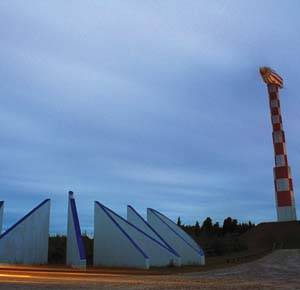
Stanton Moor is situated in Derbyshire’s beautiful Peak District National Park, in the heart of England. At first glance up here, it’s all foxgloves, purple heather and wildflowers. But if you have an archaeologist’s eye, like my friend Ian Jackson, you can detect something more deliberately patterned in the rocky formations that stretch out to the horizon in every direction: the outline of a Bronze Age roundhouse, sunken into the rock-strewn moor. The walls are long fallen and weathered away. Ian pointed out the narrow path that leads downwards and suddenly I saw it too. I stepped into the entrance and back through time. I was in someone’s home.
“We’re closer to the Bronze Age people than they were to those who built Stonehenge,” Ian observed. For a moment I was struck silent with the majesty of that timescale.
I had come Bronze Age hunting because, like many people it seems, I have recently become fascinated with the pre-Roman peoples of the British Isle. My walk was partly prompted by the British Museum’s blockbuster early summer exhibition on Stonehenge, the Neolithic stone circle in Wiltshire. Such stone circles pepper the length and breadth of this island nation. Not far from Stanton Moor is Arbor Low, another Neolithic stone circle at which the stones are now flat on the ground. Historians believe they were deliberately knocked down by medieval people, fuelled by their own superstitions.
Stonehenge is a monument that Brits tend to think of as archetypically British. But the exhibition confounded all expectations. A wall mounted with dozens of beautiful stone axe heads from all over Europe revealed, post-Brexit, an almost provocatively counterintuitive picture; Britain connected by a large land bridge to northern Europe, with Stonehenge as the trading and pilgrimage heart of a borderless world. Recent excavations have provided plentiful evidence of trade from further afield – pottery, jewellery and weapons from the Middle East, North Africa and Asia Minor. More intriguing still were the mysterious carvings of flowing spirals and cups and rings, on giant rocks and boulders found across Europe, from Germany to Scotland.
The British Museum show was fascinating – but there were some troubling aspects too. The exhibition included skeletons that had been unearthed in graves. One was the skeleton of a woman who was still clutching the outline of her dead baby, a bag of more than a hundred animal teeth buried with them as a spiritual offering. After more than a century of challenge, museums would not, I think, dare to display the human remains of ancient First Nation peoples this way. On the one hand, modern Europeans claim a kinship with these ancient brothers and sisters, and yet we tolerate what could be seen as the desecration of their graves. With their belief systems long lost, they have no one to advocate for them.
And yet there is an honest spiritual craving in our modern behaviour around ancient monuments. Stonehenge is now understood to have been built in line with the natural cycle of the Earth’s rotation around the Sun, aligning with sunrise during the solstices. Humanists surely recognise the pull of acknowledging our place in the beautiful but indifferent Solar System.
Iwitnessed this pull in action on that day before the summer solstice when Ian and I walked on Stanton Moor. Not far from where Ian pointed out the outline of ancient homes is a Bronze Age stone circle known as the Nine Ladies. Around it, a tent city had grown up, of young families as much as old hippies, wanting to be part of something bigger than themselves. Such gatherings have been happening all over the country at stone circles.
Part of it, I’m sure, is that after all the Covid lockdowns, we are still cherishing our right to roam freely and be with others. But there seems to be something else we are craving. It may seem that we know very little about our ancient ancestors. We don’t have a good idea of how they looked, and even their bones have mostly vanished. But they have left the most tantalising glimpses: jewellery made of black obsidian; gold torques of such weight and braided beauty it’s dazzling to imagine them worn in ritual acts. It’s also pleasing to discover that some of the finds in the Stonehenge exhibition suggest women may well have held positions of power in these societies, as shamans.
These were humans living on a minute timescale compared to the weathered rocks of their monuments. Yet their mystery binds them to us. We are drawn to the idea of their transience – for what did the pandemic do more to reveal than the fragility of our own lives?
This piece is from the New Humanist autumn 2022 edition. Subscribe here.

